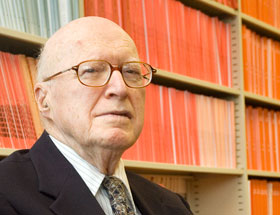  |
| HOME | THIS ISSUE | CALENDAR | GRANTS | BACK ISSUES | < BACK | NEXT > |
Emeritus physics professor to be honored with colloquiumby Cindy Weiss - October 17, 2005 |
||||
|
Paul Klemens, emeritus professor of physics, celebrated his 80th birthday in May. The celebration will continue on Oct. 21 with a World Year of Physics Colloquium lecture organized by the physics department in his honor, “Modern Applications of Phonons: Contributions of Paul G. Klemens.” Klemens “has been one of the very top people in the world for years on the theory of phonons,” says Douglas Pease, a professor of physics and, like Klemens, a condensed matter physicist. Klemens’s colleague and scientific collaborator, Michael Stroscio, a professor of electrical and computer engineering and University Scholar at the University of Illinois, Chicago, will deliver the lecture on phonons, which are particles of elastic energy, the quanta of electric waves, and are “really what constitutes heat in a solid,” says Klemens, as they interact and generate thermal waves. Since the early 1950s, Klemens, a theoretical physicist, has worked on and expanded the theory of heat conduction in solids. In 1986, he was the first recipient of the Phonons Award, given every three years by the International Conference on Phonon Scattering in Condensed Matter, honoring those who have made longstanding contributions to phonon physics. In 2001, the award was renamed the Klemens Award. His reputation may be large, but Klemens has a quiet, unpretentious manner. Once, at a conference on thermal conduction, a scientist from Oak Ridge National Laboratory was speaking during a pre-conference reception, recalls Dwight Damon, professor emeritus of physics and longtime colleague. “Paul made a comment, and the guy turned to him and said, ‘Who do you think you are, Paul Klemens?’” Damon says. “Paul was sort of taken aback, and he said, ‘Yes, I am!’” Klemens was born in Vienna in 1925, the son of Jewish parents who had a textile business, supplying yarn to petit point workshops. When Paul was 12, his father was arrested by the Nazis and put in a concentration camp. He was later released, and the family fled to Australia in June 1939, shortly before war broke out. Paul learned to speak English and began high school studies in his new country. “It turned out I was good at mathematics,” he says, and he won a scholarship to the University of Sydney, where he earned bachelor’s and master’s degrees. As an undergraduate, Klemens planned to study math, but he became interested in physics as a system of looking at the world. “It’s nice to be able to explain lots of phenomena that you encounter in your life,” he says. At first he wanted to become an experimental physicist, “but I was terrible in the laboratory,” he says. “They told me, ‘Wouldn’t it be better if you did theoretical physics?’”
“I was completely uninterested in it at first,” he says, “but there is no problem in physics that, if you work on it, doesn’t become interesting.” So interesting that thermal conductivity became his life’s work. As it turned out, that was his forte. He won a scholarship to Oxford in 1948, and when he arrived late on a slow boat from Australia, the other physics graduate students in his group had already selected their problems for the year. He was left with the one nobody else wanted, on thermal conductivity. During his three years in England, Klemens earned a Ph.D. and married Ruth Wiener, a native of Berlin who was then a student at the University of London. The couple returned to Paul’s adopted country of Australia, and he became principal research officer at the National Standards Laboratory. In 1959 they came to the United States, where Paul joined the Westinghouse Research Laboratories, heading a group that worked on thermo-electric energy, fuel cells, and an early version of what later was known as “Star Wars” missile defense technology. In 1967 he was persuaded, after two recruitment efforts, to head the physics department at UConn. Klemens has supervised 13 Ph.D. and other graduate students over the years. He stepped down as department head in 1974 and retired in 1991. Until recently, when prevented by health problems, he came into the physics department every day. He has a number of patents, among them, one with General Electric for his theoretical work on thermal barrier coatings, which are thin but thermally insulating layers that protect underlying metal parts and are used in jet engines. Klemens may not have been adept at experimental physics, but he has been generous in contributing theoretical insights to the experimentalists at UConn, says his colleague, Douglas Pease. Most theorists have little to do with the experimental side of physics, Pease adds. But Klemens is also “great at figuring out what’s going on. He’s got a sort of intuitive feeling for it.” Ruth and Paul Klemens live in Mansfield. Ruth, who received a master’s degree in French from UConn in 1972, taught French in the East Hartford schools. |
| ADVANCE HOME UCONN HOME |

